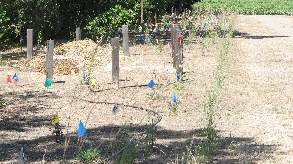Note: As of March 1 2019, this application is no longer supported.
Please use the
Calflora Planting Guide instead -- it has the latest and best information.

|
Euphydryas chalcedona,
Variable Checkerspot
© 2008 Ron Wolf
(CalPhotos)
|
Pest Predators and Pest Parasites
Excellent information on pest predators and parasites is available on the
UC Integrated Pest Management
website.
Pest predators are apparently attracted to
the presence of pest insects rather than to specific plants.
Some, such as
Syrphid (hover) flies,
feed on pollen as adults (and thereby act as general pollinators),
but feed on soft bodied insects (aphids) in the larval stage.
Planting for Pollinators and Beneficial Insects
A strategy for attracting pollinators and other beneficial insects
involves planting so as to provide sources of pollen year round.
On the Plants for Projects page,
plants are displayed with their bloom periods.
This should make it possible to choose plants to cover the
whole year. For instance:
Amorpha fruticosa
western false indigo
|
 |
Feb - Apr |
Ceanothus thyrsiflorus
blueblossom
|
 |
Mar - May |
Eriodictyon californicum
Yerba santa
|
 |
May - Jun |
Eriogonum fasciculatum
California buckwheat
|
 |
Jun - Aug |
Grindelia camporum
gumweed
|
 |
Aug - Oct |
Baccharis pilularis
coyotebush
|
 |
Oct - Jan |
Pests
Among the worst pests facing grape growers is
the
glassy-winged sharpshooter,
because it can
spread Pierce's disease (see this
note from the CA Department of Food and Agriculture).
The causal bacterium, Xylella fastidiosa, lives in other plants
(including many native plants), and sharpshooters can spread the
bacterium from those plants to grapevines, or from one grapevine to another.
From this point of view, care must be taken to ensure that
both plants which host the baterium
and plants which host the sharpshooter
are not growing too close to a vineyard.
Grape whitefly
is another vineyard pest which is hosted by coffeeberry,
hawthorn, and wild native grapes.
European grapevine moth
is another vineyard pest recently arrived in Calfornia,
known to be hosted by several Prunus
species and olive trees.
References
